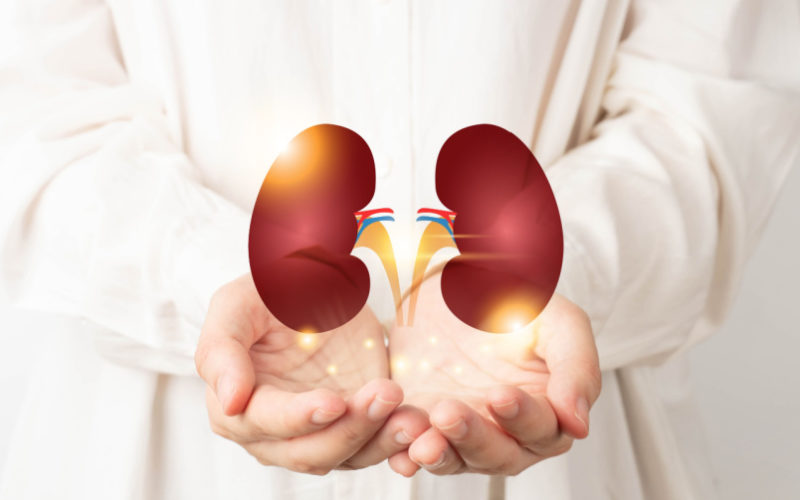Nephrotic syndrome is a kidney disorder that primarily affects the glomeruli, the tiny filters in the kidneys responsible for removing waste products and excess fluid from the blood. It is characterized by significant proteinuria, hypoalbuminemia, oedema, and hyperlipidaemia. In children, nephrotic syndrome is most commonly diagnosed between the ages of 2 and 7 years, with a peak incidence around 3 years of age. It is not a single disease but rather a collection of symptoms and laboratory findings that indicate kidney dysfunction. In this blog, we aim to provide a comprehensive guide to understanding nephrotic syndrome, its causes, symptoms, diagnosis, and possible treatment options.
What are the causes of Nephrotic Syndrome?

Nephrotic syndrome can occur due to a variety of underlying conditions, both primary kidney diseases and secondary systemic diseases. These including:
Minimal Change Disease: This is one of the most common primary causes of nephrotic syndrome, especially in children. The exact cause is often unknown, but it is characterized by subtle changes in the glomeruli as seen under a microscope.
Focal Segmental Glomerulosclerosis (FSGS): FSGS is another primary glomerular disease that can lead to nephrotic syndrome. It is characterized by scarring in some segments of the glomeruli.
Membranous Nephropathy: This is a primary glomerular disease where the glomerular basement membrane thickens and becomes inflamed.
Diabetes: Diabetic nephropathy is a common secondary cause of nephrotic syndrome. Persistent high blood sugar levels can damage the glomeruli over time.
Systemic Lupus Erythematosus (SLE): Lupus nephritis, a complication of systemic lupus erythematosus, can lead to nephrotic syndrome as the immune system attacks the kidneys.
Amyloidosis: In this condition, abnormal protein deposits called amyloids can accumulate in the kidneys, leading to nephrotic syndrome.
Hepatitis B and C: Chronic viral hepatitis infections can sometimes lead to nephrotic syndrome as the immune response affects the kidneys.
HIV/AIDS: Human immunodeficiency virus (HIV) infection can lead to various kidney diseases, including nephrotic syndrome.
Certain Medications: Some medications, such as nonsteroidal anti-inflammatory drugs (NSAIDs), certain antibiotics, and non-prescription pain relievers, can cause kidney damage and nephrotic syndrome in some individuals.
Malignancies: In rare cases, certain cancers, such as lymphomas, can lead to a paraneoplastic form of nephrotic syndrome.
What are the symptoms of Nephrotic Syndrome?

Nephrotic syndrome is characterized by unique signs and symptoms, which can vary in severity among individuals. The common signs and symptoms of nephrotic syndrome include:
Some of the other conditions for which children may require a kidney transplant includes:
Oedema (Swelling): One of the most noticeable symptoms of nephrotic syndrome is oedema, which is the accumulation of excess fluid in the body's tissues. It often starts in the face, particularly around the eyes, and can progress to involve the legs, ankles, and abdomen. The swelling may make the affected areas appear puffy or swollen.
Massive Proteinuria: Nephrotic syndrome results in the loss of a large amount of protein, particularly albumin, through the urine. This excessive protein excretion can lead to frothy and foamy urine.
Hypoalbuminemia: The loss of albumin in the urine results in low serum albumin levels, contributing to oedema and decreased oncotic pressure (pressure in the blood vessels) in the blood.
Hyperlipidaemia: Nephrotic syndrome can lead to elevated levels of lipids (cholesterol and triglycerides) in the blood. This is often a compensatory response to hypoalbuminemia and can result in an increased risk of cardiovascular problems.
Hypercoagulability: Some patients with nephrotic syndrome are at an increased risk of blood clot formation due to the loss of anticoagulant proteins in the urine.
Hypercoagulability: Some patients with nephrotic syndrome are at an increased risk of blood clot formation due to the loss of anticoagulant proteins in the urine.
Fatigue and Weakness: Low albumin levels and anaemia (reduced red blood cell count) can lead to fatigue and a general feeling of weakness.
Increased Susceptibility to Infections: The loss of immunoglobulins in the urine can weaken the body's immune system, making individuals more susceptible to infections.
Abdominal Discomfort: Enlargement of the liver and kidneys can cause mild to moderate abdominal pain or discomfort.
How is Nephrotic Syndrome Diagnosed?

Diagnosing nephrotic syndrome involves a combination of clinical evaluation and laboratory tests. The tests and procedures to diagnose nephrotic syndrome include:
Urine tests: These tests are essential in diagnosing nephrotic syndrome. They detect high levels of protein (albumin) in the urine, known as proteinuria, and low levels of serum albumin in the blood. Additionally, urine may show lipid droplets and casts. These findings help confirm the presence of nephrotic syndrome.
Blood Tests: Comprehensive blood tests may be performed to evaluate kidney function, detect underlying diseases or conditions, and monitor electrolyte levels.
Kidney Biopsy: A kidney biopsy is an important diagnostic tool to differentiate between primary and secondary causes of nephrotic syndrome and to assess the extent of kidney damage. A small sample of kidney tissue is obtained and examined under a microscope.
Renal Ultrasound: This imaging test can help assess the size and structure of the kidneys, which may provide information about any physical abnormalities or conditions affecting the kidneys.
Immunological Tests: In some cases, tests for specific antibodies or markers related to autoimmune or systemic diseases may be performed to identify secondary causes of nephrotic syndrome.
How is Nephrotic Syndrome Treated?

The treatment of nephrotic syndrome depends on the underlying cause, as well as the specific symptoms and needs of the patient. Various treatment aspects of nephrotic syndrome include:
Management of Underlying Cause: If nephrotic syndrome is secondary to another condition, such as diabetes or lupus, the primary disease must be managed effectively to address the nephrotic syndrome. For example, controlling blood sugar in diabetes or treating systemic lupus erythematosus in lupus nephritis.
Immunosuppressive Therapy: In cases of primary nephrotic syndrome, such as minimal change disease, focal segmental glomerulosclerosis (FSGS), etc., immunosuppressive medications may be prescribed. These drugs, including corticosteroids and other immunosuppressants, help reduce inflammation and proteinuria.
Diuretics: Diuretic medications may be prescribed to manage oedema (swelling) by increasing urine output and reducing fluid accumulation. The choice of diuretic and dosage depends on the patient's clinical condition and response.
Dietary Modifications: Patients are often advised to follow a low-sodium diet to help control oedema. Reduced intake of salt can help manage fluid retention. Dietary recommendations may vary based on the extent of oedema and the patient's overall health.
Cholesterol-Lowering Medications: Statin medications may be prescribed to manage hyperlipidaemia (high cholesterol and triglyceride levels). Lowering lipid levels can help reduce the risk of cardiovascular disease, which is increased in nephrotic syndrome.
Anticoagulants: In some cases, anticoagulant therapy may be necessary to prevent blood clot formation. Nephrotic syndrome patients are at an increased risk of developing blood clots due to the loss of anticoagulant proteins in the urine.
Angiotensin-converting enzyme (ACE) Inhibitors: These medications are often used to manage blood pressure and reduce proteinuria in some patients with nephrotic syndrome. They help protect the kidneys and reduce the risk of complications.
Supportive Care: Nephrotic syndrome patients may need supportive care to address various complications.
To conclude, it’s important to note that treatment for nephrotic syndrome is individualized based on the patient's specific condition, including the underlying cause, symptom severity, and response to therapy. The goal of the treatment is to alleviate symptoms and prevent complications while improving the patient's overall quality of life. Therefore, treatment plans should be developed and closely monitored by a healthcare team, which may include nephrologists, dietitians, and other specialists, as needed.
NU Hospitals in Bangalore, India, stands as a premier destination for comprehensive nephrotic syndrome care, offering state-of-the-art facilities and is renowned for its successful kidney transplants, providing hope to countless patients with end-stage renal disease. Moreover, the hospital excels in pediatric kidney care, ensuring compassionate and specialized treatment for young patients facing kidney-related issues. With a commitment to excellence, NU Hospitals is dedicated to improving the lives of individuals suffering from nephrotic syndrome and advancing the field of kidney care.
References.
Author: Dr. Nitin Nayak

